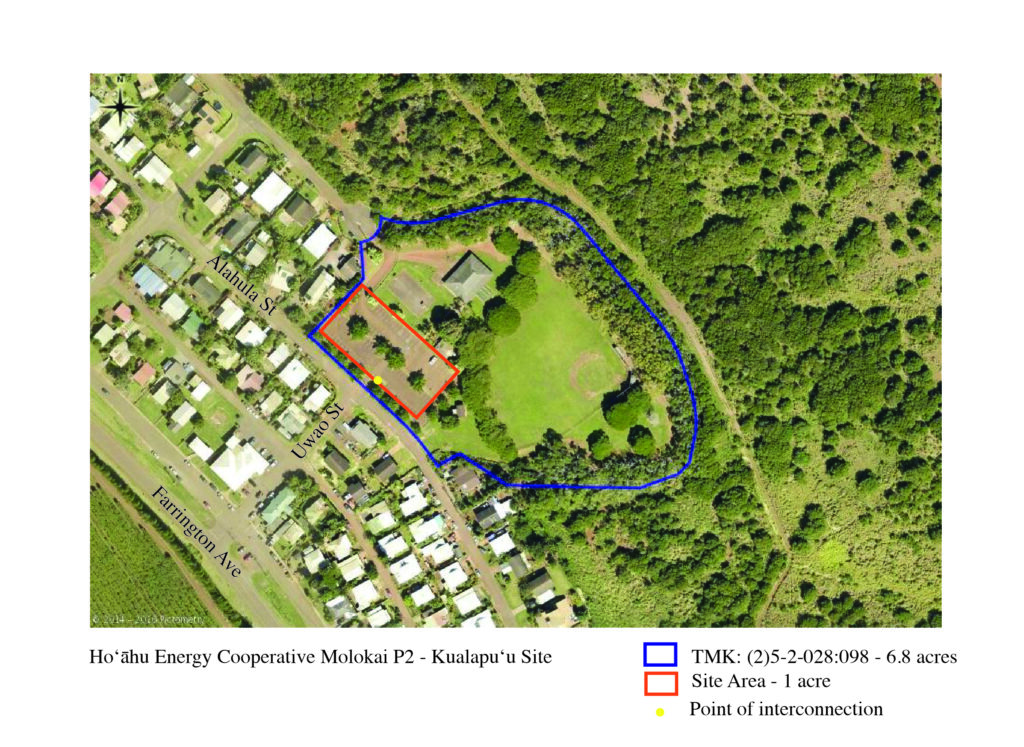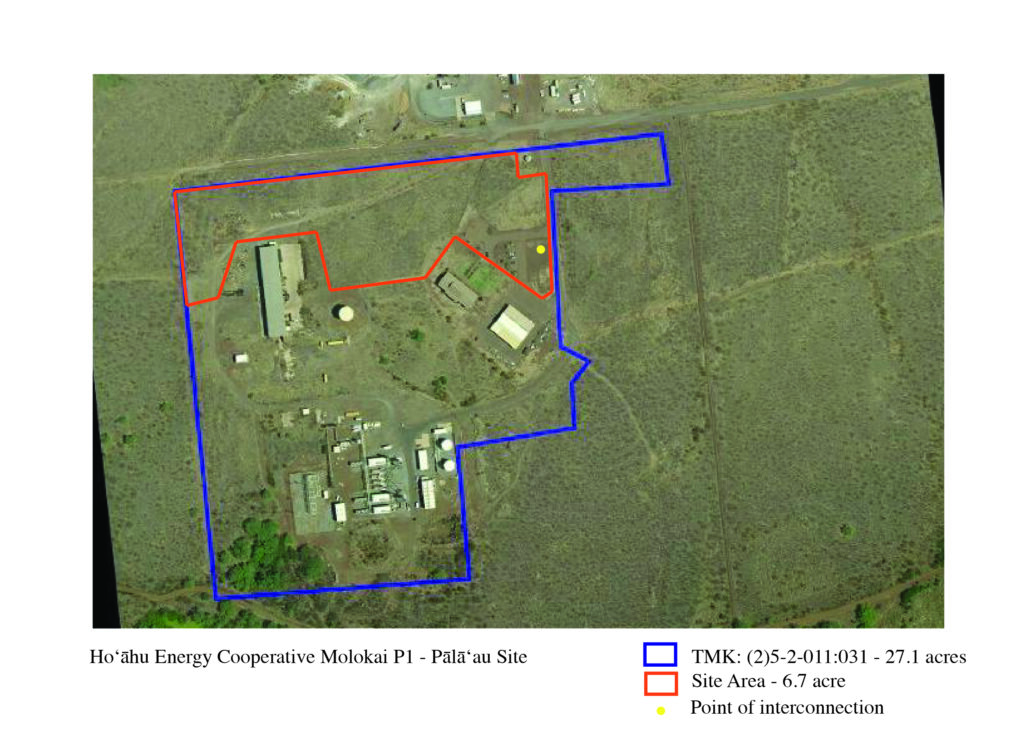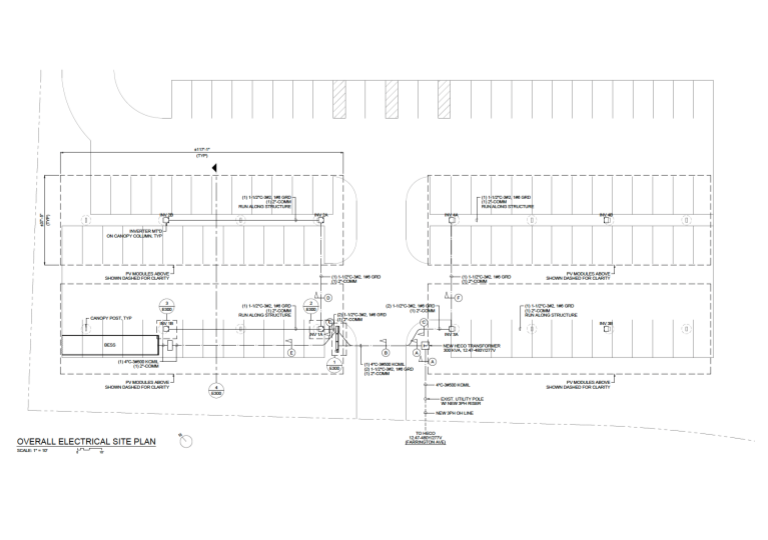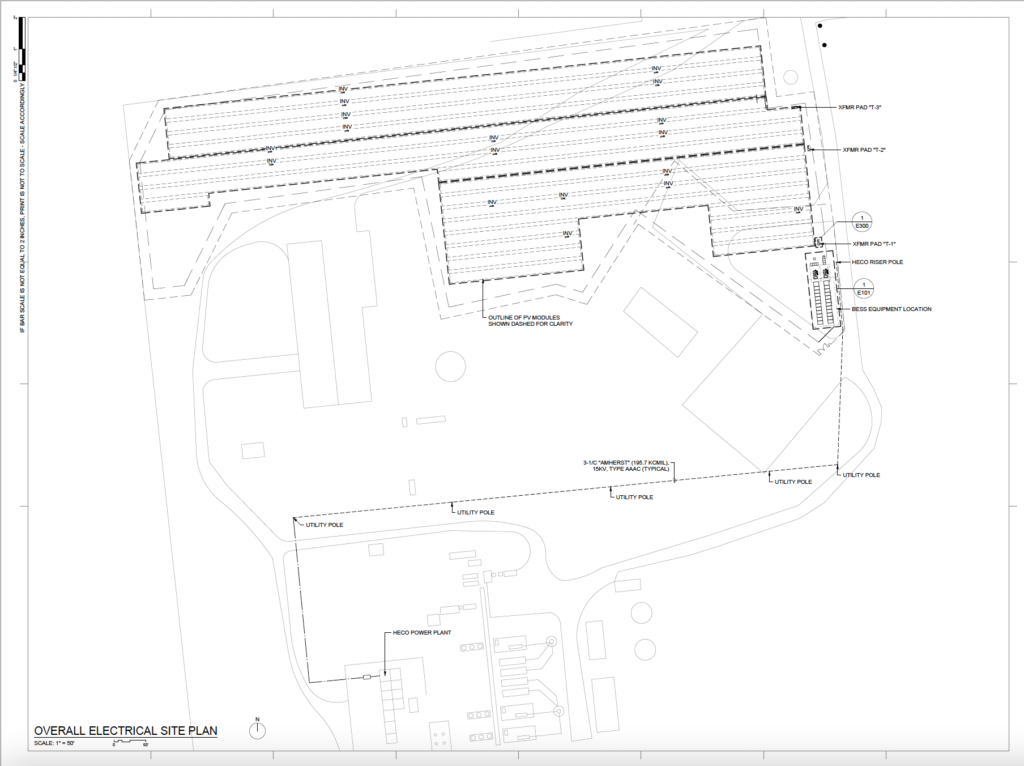Hoʻāhu Energy Cooperative Molokai (Hoʻāhu) was first formed in 2020 by Molokaʻi community advocates to enable our island residents to design and own renewable energy projects built on Molokai. Hoʻāhu’s first effort was to design solar and storage project proposals to submit to Hawaiian Electric’s Community-Based Renewable Energy (CBRE) Request for Proposals (RFP). This effort resulted in two solar photovoltaic (PV) and battery energy storage system (BESS) projects, which were designed by the Molokai community through over 40 public workshops from March 2020 to March 2022. In December 2022, Hoʻāhu and Hawaiian Electric finalized terms and details for these projects – which are the first community-owned community solar projects being developed in Hawaiʻi!
Below are details about the projects. Please see our joint press release here for additional news!
Proposer and Project Owner: Hoʻāhu Energy Cooperative Molokai
Co-development Partners: Shake Energy Collaborative and Mana Pacific, Inc.
| Project Name | Kualapuʻu Community Based Renewable Energy Project | Pālāʻau Community Based Renewable Energy Project |
| Net Nameplate Capacity | 250 kW AC of Solar PV paired with 1 MWh BESS | 2.2 MW AC of Solar PV paired with 10.1 MWh BESS |
| Location | Kualapuʻu Recreation Center, 1 Uwao St, Hoʻolehua, HI | Adjacent to the Pālāʻau Power Plant on Ulili St, Kaunakakai, HI |
| TMK | (2)5-2-028:098 | (2)5-2-011:031 |
| Point of Interconnection | Circuit 110B | Pālāʻau Power Plant |
| Facility description | This proposed project is located at the Kualapuʻu Park and Community Center, a County of Maui facility at the corner of Uwao St and Alahula St in the town of Kualapuʻu. The proposal includes a 250 kW AC (325 kW AC) PV array mounted on carport structures over the existing parking lot, paired with a 250 kW AC (1MWh) BESS. The selected battery technology is Lithium Iron Phosphate (LFP). | This proposed project is located at a parcel owned by Hawaiian Electric adjacent to Pālāʻau Power Plant on Ulili Street in Kaunakakai. The proposal includes a 2.2 MW AC (3.3 MW DC) ground-mounted PV array paired with a 2.2 MW (10.1 MWh) BESS. The PV and BESS collectively cover approximately 6.7 acres of land. The selected battery technology is Lithium Iron Phosphate (LFP). |
Environmental and Cultural Impacts
As a community-based organization, Hoʻāhu is committed to only developing projects that benefit our community and the natural and cultural environment we depend on. Therefore, we spend significant time understanding what potential impacts renewable energy can have on our environment and designed the projects to minimize those impacts – such as using already-developed land when possible and selecting non-toxic materials and equipment. Below please find our assessments of the potential environmental and cultural impacts of the proposed projects, along with the permitting activities we will undertake.
Kualapuʻu Permitting Plan
The proposed layout places four solar carports over the existing parking lot at Kualapuʻu Park and Community Center along with a BESS in a single shipping container next to the parking lot. The installation of the carport structures may also be paired with a repaving of the parking lot in collaboration with the County of Maui Parks Department. The site is located on Interim zoned land in the middle of the residential and commercial center of Kualapuʻu.
The use of County-owned land is a trigger for an Environmental Assessment (EA), however the minimal nature of the potential impacts of this small project on currently developed land may qualify the project for an exemption. The federal grants that Hoʻāhu is applying for this project may require a similar level of analysis as an EA so we have budgeted for this level of environmental compliance with time and resources. We have been in conversation with the Department of Park, Capital Improvements Division, about the project’s necessary permitting – which will likely be minimal due to the planned use being a permitted use under Interim Zoning.
| Permit/Approval Name | Start Date | End Date |
| County Site Control | 1/14/23 | 4/15/23 |
| SHPD Consultation | 4/15/23 | |
| Environmental Assessment | 4/15/23 | 4/14/24 |
| Building permit | 8/27/23 | 2/26/24 |
| Noise Permit | 8/27/23 | 9/16/23 |
| Federal Aviation Permit | 8/27/23 | 9/21/23 |
| Grading Permit | 8/27/23 | 9/26/23 |
| Structural Permit | 8/27/23 | 10/6/23 |
| High Voltage Permit | 8/27/23 | 10/6/23 |
| SWPP/NPDES Permit | 8/27/23 | 9/16/23 |

- State of Hawaii, Department of Health, Noise Permit. The installation contractor will apply for this permit on behalf of the project once the project design is finalized. The Proposer team will oversee the submission of the application.
- County of Maui, Development Services Administration, Building and Construction Permit. The installation contractor will apply for this permit on behalf of the project once the project design is finalized. The Proposer team will oversee the submission of the application.
- County of Maui, Department of Public Works, Electrical Permit. The installation contractor will apply for this permit on behalf of the project once the project design is finalized. The Proposer team will oversee the submission of the application.
- County of Maui, Department of Public Works, Development Services Administration, Grading & Grubbing Permit. The installation contractor will apply for this permit on behalf of the project once the project design is finalized. The Proposer team will oversee the submission of the application.
- State of Hawaii, State Historic Preservation District Consultation, Historic Preservation Review (HRS Ch. 6E) – The Proposer Team will initiate this consultation in Q2 2022, with the support of the Team’s contracted Cultural Practitioners, because the consultation can be one of the longer approvals to receive. The Proposer Team will consult with SHPD to determine if a full AIS is required. If it is required, then the Proposer Team will work with Hawaiian Electric to confirm a qualified archeological consultant to perform the AIS as soon as Hawaiian Electric will allow.
- State of Hawaii, Department of Health, Clean Water Branch, National Pollutant Discharge Elimination System (NPDES) Permit. The installation contractor will apply for this permit on behalf of the project once the project design is finalized. The Proposer team will oversee the submission of the application.
- County of Maui, Department of Public Works, Stormwater Pollution Prevention Plan. The installation contractor will apply for this permit on behalf of the project once the project design is finalized. The Proposer team will oversee the submission of the application.
State of Hawaii, Office of Planning and Sustainable Development, Environmental Review Program, Environmental Assessment. The Proposer Team, specifically Shake Energy Collaborative, will work with the sponsor agency, the County of Maui Department of Parks and Recreation, to determine whether the project may be considered “de minimis” and therefore given an exemption to the EA requirement. If an EA is determined to be needed, Shake will draft and submit a DEA within 1 month of determination and expects an issued Finding of No Significant Impact (FONSI) within 1 year.
City zoning and state land use classification
The proposed site is located in an area designated by the State as an Urban Land Use District (LUD). The County Zoning for the area is “Interim”. The site is not in a Special Management Area. The Flood Hazard Area Zone is classified as Zone X, as determined through the Department of Land and Natural Resources Flood Hazard Assessment Tool. According to conversations with the County Department of Parks, the proposed use falls under the category of public utility, which is an allowable use in Interim Zoning. The use of County-owned land is a trigger for an Environmental Assessment (EA). However, the impact of the project, being built over a previous development plot of land without obstructing the current use of the land, would likely be considered “de minimis” and qualify the project for an EA exemption. The Proposer Team will work with the County of Maui to determine if this exemption is appropriate, but the Team has budgeted time and resources to prepare an EA in case it is needed.
Preliminary Environmental Assessment of the Site
Hoʻāhu prepared a preliminary assessment of the site and potential impacts of the project on the existing conditions. Please see the document below for this initial document, which will be built upon for future permitting needs.
Pālāʻau Permitting Plan
The proposed layout places a medium-scale PV array and BESS on currently vacant land on an industrial parcel adjacent to other industrial uses in the area of Pālāʻau. Because of the zoning of the parcel, which is owned privately by Hawaiian Electric, and the scale of the development being less than 15 acres, among other reasons, an Environmental Assessment and other zoning permits are not currently required for the project.
Hoʻāhu, however, is committed to thoroughly assessing any environmental, social or cultural impacts the project may have on Molokai. Therefore, the Proposer Team will work closely with its contracted cultural practitioners and relevant agencies to confirm any impacts previously unaccounted for and any potential compliance needed. Hawaiian Electric has commissioned two studies – a Cultural Report and Geotechnical Report – of the site and nearby area, which the Proposer Team found useful in preparing its layout. The Proposer Team will work with Hawaiian Electric to commission additional surveys upon contract award including Boundary, Topographic, and Geotechnical Surveys and an Archeological Inventory Survey if it is confirmed as necessary in the consultation with the State Historic Preservation District (SHPD). The Proposer Team will also work with Hawaiian Electric to have a Phase I or Phase II baseline environmental site assessment conducted, as required in the CBRE RFP.
| Permit Name | Start Date | End Date |
| SHPD Consultation | 1/14/23 | 1/14/24 |
| AIS | 1/14/23 | 3/15/23 |
| Building permit | 9/11/23 | 3/12/24 |
| Noise Permit | 9/11/23 | 10/1/23 |
| Federal Aviation Permit | 9/11/23 | 10/6/23 |
| Grading Permit | 9/11/23 | 10/11/23 |
| Structural Permit | 9/11/23 | 10/21/23 |
| High Voltage Permit | 9/11/23 | 10/21/23 |
| SWPP/NPDES Permit | 9/11/23 | 10/1/23 |

- State of Hawaii, Department of Health, Noise Permit. The installation contractor will apply for this permit on behalf of the project once the project design is finalized. The Proposer team will oversee the submission of the application.
- County of Maui, Development Services Administration, Building and Construction Permit. The installation contractor will apply for this permit on behalf of the project once the project design is finalized. The Proposer team will oversee the submission of the application.
- County of Maui, Department of Public Works, Electrical Permit. The installation contractor will apply for this permit on behalf of the project once the project design is finalized. The Proposer team will oversee the submission of the application.
- County of Maui, Department of Public Works, Development Services Administration, Grading & Grubbing Permit. The installation contractor will apply for this permit on behalf of the project once the project design is finalized. The Proposer team will oversee the submission of the application.
- State of Hawaii, State Historic Preservation District Consultation, Historic Preservation Review (HRS Ch. 6E) – The Proposer Team will initiate this consultation as soon as possible, with the support of the Team’s contracted Cultural Practitioners, because the consultation can be one of the longer approvals to receive. The Proposer Team will consult with SHPD to determine if a full AIS is required. If it is required, then the Proposer Team will work with Hawaiian Electric to confirm a qualified archeological consultant to perform the AIS as soon as Hawaiian Electric will allow.
- State of Hawaii, Department of Health, Clean Water Branch, National Pollutant Discharge Elimination System (NPDES) Permit. The installation contractor will apply for this permit on behalf of the project once the project design is finalized. The Proposer team will oversee the submission of the application.
- County of Maui, Department of Public Works, Stormwater Pollution Prevention Plan. The installation contractor will apply for this permit on behalf of the project once the project design is finalized. The Proposer team will oversee the submission of the application.
City zoning and state land use classification
The proposed site is located in an area designated by the State as an Urban Land Use District (LUD). The County Zoning for the area is M2 – Heavy Industrial, and the Community Plan designation is Heavy Industrial as well. The site is not in a Special Management Area. The Flood Hazard Area Zone is classified as Zone X. These zoning determinations were confirmed through a Zoning and Flood Confirmation Zone Form received from the County of Maui Department of Planning, attached in Appendix 4.1. The site is located outside of the 3.2-feet Sea Level Rise Exposure Area as defined by the Hawaiʻi Sea Level Rise Viewer.
The proposed use fits the definition of “Major utility facilities” in the County of Maui codes. Major utility facilities are a permitted use in M2 zones, which means that a Special Land Use permit is not required for the proposed project.
Preliminary Environmental Assessment of the Site
Hoʻāhu prepared a preliminary assessment of the site and potential impacts of the project on the existing conditions. Please see the document below for this initial document, which will be built upon for future permitting needs.
Analysis of Cultural Impacts
Hoʻāhu is committed not only to ensuring that its projects avoid impacting ancient cultural resources but is also designing its projects to fit into the current landscape of cultural practice and knowledge. To that end, the Proposer Team has engaged the services of two cultural practitioners rooted in Molokai culture, past, present and future. These cultural practitioners worked with the Proposer Team to identify considerations for site layout and hosted a community workshop. The workshop was very well received by members of the community who expressed gratitude for being included early on in the practitioners’ process for understanding and assessing the project.
The practitioners report on both sites – at Pālāʻau and Kualapuʻu – is attached below.
Community Outreach Plan
These projects were conceived of, and fully designed, by community members through frequent and inclusive virtual and in-person community workshops over the last two years. Hoʻāhu will build upon this past outreach and base of community support and engagement to continue updating the Molokai community about development status, including permitting status and any opportunities for public comment, opportunities to participate in workforce development, and availability and terms of subscription.
Scoping and Community Concerns
Hoʻāhu has outreached with a wide range of community stakeholders to identify groups who may be affected by this project. We held several meetings specifically with the local homestead association to discuss whether their beneficiaries would be eligible to subscribe to this project.
One area of high concern was the potential risk of fire, and resulting community health and environmental impacts, presented by some BESS technologies. As a result of these concerns, we spent 3 months in the summer of 2021 hosting community workshops at which community members learned about and discussed the risks associated with different technologies. The community group came to a consensus that an LFP BESS was the optimal chemical battery technology available, balancing factors such as cost, commercial viability, environmental safety, and human rights. This focus on BESS allowed us all to feel confident in the technology selection presented in this proposal.
Throughout these meetings, the project description was constantly evolving as a result of community input and the changing RFP process. To ensure that new community workshop participants were up-to-date about the project description, a representative from Hoʻāhu would start each meeting with an overview of the project, followed by a deep dive into the topic of design in that workshop.
Comprehensive Outreach Strategy
The community leaders who formed Hoʻāhu chose to incorporate as a cooperative in order to put equity and democratic decision-making inherent to project development. This transparent and inclusive structure is demonstrated in how the Proposer Team formed its outreach plan which has two core elements: public workshops and targeted outreach.
Public workshops
Hoʻāhu has and will continue to hold regular community workshops which are open to the public. Leading up to this proposal preparation, the Team hosted a virtual workshop on a biweekly basis. At these workshops, the Proposer Team would explain decisions that needed to be made about the project design and community members would ask questions, discuss considerations and ultimately advise Hoʻāhu on how to proceed. These topics included: site selection, dual land use options, technology selection (both PV modules and BESS chemistries) project financing options, subscription program design, and workforce development. With much of the project already designed, future projects will likely be less frequent and hosted on an as-needed basis when the Proposer Team has updates or a decision to receive public input on.
These community workshops have largely been hosted virtually on Zoom and last 1.5 hours typically. Attendance at these meetings is open to the public. The meetings were advertised through a combination of public announcements in the Molokai Dispatch, posts in the Facebook Group “Molokai Renewable Energy”, and email invitations mailed to the distribution list of over 150 individuals.
When safe and appropriate, we will explore hosting in-person community events to expand participation. Hoʻāhu continues to host public community workshops on the 3rd Saturday of every month from 9 to 10:30 am. Please see homepage for more information on how to join in.
Targeted Outreach
In addition to open, public meetings, we reached out to specific organizations that may have aligned interests with the project. Hoʻāhu gave special presentations to groups such as the Sovereign Council of Hawaiian Homestead Associations (SCHHA) and the Molokai Chamber of Commerce about the benefits and challenges of local ownership and the importance of workforce development.
Hoʻāhu will increase this type of outreach over the Development Process and Subscriber Recruitment to ensure that groups have the opportunity to participate and give input on the construction and subscription of the project.
Community Benefits
The project has been designed to offer a number of community benefits to the residents of Molokai, including:
- Community ownership of the project which results in monetary and decision-making benefits.
- Workforce development and local hiring – Hoʻāhu has secured grant funding to run two workforce training programs in 2022 which will help to prepare a cohort of Molokai residents for employment when this project is being constructed in 2023/2024. The training will include hands-on installation work with instruction from Makaha Learning Center, in addition to microgrid design and maintenance (including BESS systems) training conducted by ASU LEAPS.
- Electricity bill savings – The project is expected to produce bill savings for subscribers of between 10% and 25%.
- Community Resiliency – by co-locating one of the PV and BESS systems at the Kualapuʻu Park and Community Center, which is being considered by Maui County as a potential Resiliency Hub location, with further assessment needed, the Project may have the potential to provide reliable power to the Kualapuʻu area residents in times of extreme weather.
Mahalo
As a cooperative, our success with these projects was made possible by the collaboration and support of many individuals and groups without whom we could never have done it alone.
Hoʻāhuʻs mission of community-owned energy is made possible through the support of mission-aligned funding commitments, including:
- Hawaiʻi Green Infrastructure Authority’s intent to lend up to $7.5 million from the GEMS Fund or other sources
- Inclusive Prosperity Capital’s intent to lend to or sponsor the project with the intent to enable community buy-back after the tax period
- Ulupono Initiative’s in-kind support and intent to provide financial support
- A predevelopment loan from The People’s Solar Energy Fund
Additionally, Hoʻāhu was allocated $3 million in congressionally directed spending, jointly supported by Sens. Mazie Hirono and Brian Schatz. Hoʻāhu also plans to leverage tax incentives provided through the 2022 Inflation Reduction Act, which are aimed at projects serving disinvested communities.
Hoʻāhu would like to thank the many groups and individuals who committed their time and resources to supporting this project, including: Sierra Club of Hawaiʻi, Earthjustice, Councilwoman Keani Rawlins-Fernandez, Senator Lynn DeCoite, Representative Mahina Poepoe, Molokai Clean Energy Hui, Sustʻāinable Molokai, ʻĀina Momona, and Life of the Land.



